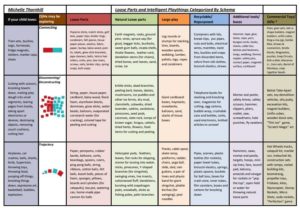Loose Parts
What are they?
Loose parts play theory was devised by architect Simon Nicholson in the 1970s, developing the idea that moveable materials that can be constructed and taken apart create limitless possibilities for creativity (LECS). He is famously quoted in ‘The Theory of Loose Parts: An important principle for design methodology’ (Nicholson, Open University) and ‘The Theory of Loose Parts: How not to cheat children‘ (Nicholson, 1971) as saying,
“In any environment, both the degree of inventiveness, creativity and the possibility of discovery, are directly proportional to the number and kind of variables in it.“
Realising the Ambition (Education Scotland, 2020) agrees with Nicholson’s original idea, saying, “Materials should be open ended to develop children’s creativity. A simple reorganisation of the resources available might be all that is needed to raise the children’s curiosity” (p. 50). It further expands to say, “Open-ended experiences and materials allow more exploration. They often lead to deeper and more creative learning as the child is empowered by the fact they cannot respond in a “wrong” way” (p. 65). And finally, that loose parts, “Provide both open-ended and structured materials which can support and challenge my learning in literacy, numeracy and mathematical thinking, and other curricular areas, in a meaningful way” (p. 69).
“Loose parts play is the label given to any collection of natural or man-made materials that can be used to expand upon children’s play. Loose parts have no specific function or goal. They can be moved, arranged, designed, taken apart and more.”
(Everything You Need to Know About Loose Parts Play for Kids, Fantastic Fun and Learning website/Michelle Lipp)
Play Scotland (2022) explains, “Introducing simple, everyday objects can improve creativity, boost social and problem-solving skills and support inclusion. “A ‘loose parts’ toy, is open-ended; children may use it in many ways and combine with other loose-parts through imagination and creativity. Nature, which excites all the senses, remains the richest source of loose parts” (Richard Louv).
“When children interact with loose parts, they enter a world of “what if” that promotes the type of thinking that leads to problem solving and theoretical reasoning. Loose parts enhance children’s ability to think imaginatively and see solutions, and they bring a sense of adventure and excitement to children’s play” (Daly and Beloglovsky, Play Scotland, 2022).
“When children play in a space or play with an object, they experience it in a unique way. Rather than its intended purpose, they may view it in terms of its affordances…. creates a richer environment for children, allowing them to do what they need to do, to follow their interests and go where their curiosity takes them.”
(Loose Parts Play: A Toolkit by Theresa Casey & Juliet Robertson, Inspiring Scotland, 2019, Second Edition, p. 7)
Key messages:
- Initially, loose parts may appear to be a collection of random resources, yet they provide children with open-ended opportunities to be creative and imaginative, exploring and solving problems.
- The use of loose parts supports heuristic play (a concept first introduced by Elinor Goldschmied), which is motivated by a child’s natural curiosity and involves sensory exploration. As a result, children have the opportunity to explore real life objects and learn about the world around them.
- Planning for effective implementation of heuristic play must involve professional reading to ensure key principles are understood.
- Spaces indoor and outdoor include access to well-organised ‘loose parts’, with outdoors offering bigger resources and more physical gross motor opportunities.
- Children have access to both natural and man-made loose parts to support their creative and imaginative play.
- Children are engrossed in deep and meaningful open-ended play using loose parts.
- Loose parts are accessible and can be used across different spaces in Early Learning and Childcare settings (ELC), indoors and outdoors and alongside other resources, e.g. block play, small world, sand, water, playdough, etc.
- The use of treasure baskets can present sensory opportunities for exploration to babies and toddlers who are not yet mobile. These should be filled with a range of natural and man-made materials, but not plastic and can be themed, for example, reflective, metal, wood or noisy (See heuristic play page for further details).
- Practitioners value and recognise the potential learning opportunities afforded using loose parts, supporting opportunities for cooperation, collaboration, problem-solving, and teamwork amongst the children. Learning dispositions can be introduced naturally within these situations.
- Practitioners use books as a provocation to inspire creative use of loose parts and display these close to the loose parts.
- Practitioners model the potential use of loose parts and use sensitive interactions to provide meaningful learning opportunities.
- Practitioners use loose parts to develop children’s conflict resolution and risk management knowledge.
- The use of loose parts significantly enhances the development of social skills, resilience and supports inclusion for all children.
Ways we can do this:
All loose parts are clean, safe and appropriately risk-assessed. Practitioners should consider the developmental stage of current cohorts, especially 2-year-olds, and the use of a risk-benefit assessment (See templates below).
Storage containers could be natural, e.g. wicker baskets are well organised with photos to clearly show which material should be stored.
Open shelving unit or trolley makes baskets of resources easy to access and store. Treasure baskets should be available on the floor for easy access by babies and toddlers who are not yet crawling.
Practitioners carefully consider what loose parts to include, evaluating them for their open-ended play potential and ensuring a mix of natural and man-made materials.
Introduce a few different loose parts at a time, especially if children are new to them. These can be swapped, changed regularly, and gradually increased as children become familiar with them.
Establish expectations when using loose parts and practitioners support children in evaluating risk, e.g. is that a safe choice?
Practitioners understand and value the potential learning opportunities using loose parts.
Careful consideration of available loose parts allows children to develop early mathematics (shape, measure, symmetry) and STEM skills (testing hypotheses, exploring weight and balance).
Practitioners spend time in this space modelling, supporting and valuing play.
Practitioners recognise the importance of large connectives (rope, piping, tubing, guttering, wooden planks) and small connectives (material, velcro, ribbons and bungee cords) to enhance the potential of loose parts.
Practitioners value children’s investigation and exploration of loose parts and extend this through sensitive and well-timed interactions.
Practitioners scaffold and support children’s thinking with phrases such as “I wonder….”, using narration to explain and integrate the ideas of others (making learning visible).
Practitioners make their thinking explicit to the children by verbalising what they are doing, e.g. ‘I’m making a face. This is for the nose, eyes’, or ‘I’m building a castle – these parts are the doors or the turret’, etc.
Practitioners make creations and use loose parts in multiple ways with the children to model the potential learning opportunities. During these sessions, explaining and demonstrating joining materials, balancing, STEM skills etc., can be naturally included within the conversation. Practitioners can gather additional resources as needed to support the learning as it occurs or suggest ways of extending the project.
Practitioners use observation to inform future planning, e.g. adding ‘challenge’ to the play by considering different levels, surfaces, transporting and holes (see Loose Parts Play: A Toolkit, p. 42-43 for ideas).
Practitioners use observation to develop the children’s schematic use of loose parts, e.g. providing various materials (tubes, tunnels, boxes) to support enclosure schema or containers to facilitate the transportation of loose parts. Realising the Ambition (Education Scotland, 2020) says, “If children are engaged in transporting schema, then practitioners will be able to provide the right loose parts, space and time to enable children to fully explore this” (p. 67).
Practitioners use observations to update their knowledge of the child’s developmental stage using Emerging Literacy developmental overviews (see tabs at the bottom of the Emerging Literacy page).
Evidence of individual and group learning is displayed and shared with children within the setting, e.g. on wall displays or in learning journals. This supports the children in knowing themselves as learners.
Linked Areas of Practice
Block Play
Creativity
Heuristic Play
Play
Spaces
Science, Technology, Engineering and Maths (STEM)
Sustained Shared Thinking
Treasure Baskets
Tools
Reflecting on Practice
SBC Guidance to support
National Guidance to support
Further Reading to support
Training to support

Risk-benefit assessment template – Play Wales
The Theory of Loose Parts – Simon Nicholson
Loose Parts by Schema:

